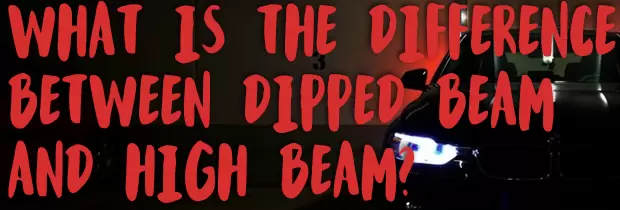What are Dipped / Main Beam Headlights?
Dipped beam headlights are what you’ll use most of the time. These are the standard or default headlights on your vehicle. When you think of turning on your headlights, you’re usually using dipped beam.
These lights are called dipped beam headlights because they actually point down. This angle ensures your dipped beam headlights illuminate the road ahead of you, rather than shooting out into the empty space directly in front of your vehicle.
In the United States and Canada, dipped beam headlights are usually referred to as “low beam” headlights, in contrast to high beam headlights, which we’ll discuss in a minute. Low beam and dipped beam are simply two names for the same thing, so don’t let the terminology confuse you.
How do high beam headlights work?
For most drivers, high beam headlights are used only on occasion. High beam headlights appear much brighter than dipped beam. Not only are they brighter, high beam headlights also point straight out, unlike dipped beam lights. Since they are angled straight ahead and produce a very bright light, high beams can be a hazard for other drivers. They shouldn’t be used in place of dipped beam headlights.
In most vehicles, you turn on your high beam headlights using the lever that controls your turn signals and dipped beam headlights. To turn on the high beams, simply push or pull the lever, depending on the model of your vehicle. Typically, you can pull the lever quickly to use high beams for just a second, or click the lever into place to keep your high beams on.
When your high beam headlights are on, your car may display a symbol on the dashboard to remind you. This ensures you won’t forget about your high beams and accidentally blind another driver.
When should dipped bean or high beam be used?
 It’s very important to know when it’s okay to use your high beam headlights. As we said before, most drivers use their dipped beam headlights almost any time light is needed to illuminate the road. However, high beam headlights can be useful in certain situations.
It’s very important to know when it’s okay to use your high beam headlights. As we said before, most drivers use their dipped beam headlights almost any time light is needed to illuminate the road. However, high beam headlights can be useful in certain situations.
If you are travelling on a road with no streetlamps, you may find it necessary to use your high beam headlights. This is especially true on country roads, where a lack of outdoor lighting can make it hard to see more than a few feet ahead with only dipped beam headlights. On winding roads, or roads with other hazards, high beam headlights will help you see obstacles and react in time.
Of course, if you’re driving down a dark road with your high beams on, be sure to turn them off if you see another driver heading towards you. If you leave your high beam headlights on, you may blind the oncoming driver and cause a collision. You should also turn your high beams off if there is a vehicle in front of you, as your high beam lights will reflect in their rearview mirror very brightly.
You should never use your high beam headlights in a busy area with lots of other vehicles. If you like to keep your headlights on at all times to maximize your visibility, be sure you are using your dipped beam lights—or better yet, consider installing daytime running lights.
Best Bulbs for Dipped and High Beam
The types of bulbs used in dipped and high beam headlights can vary. Many vehicles use single-filament bulbs in the headlamps. Single-filament bulbs have only two settings—off or on. They can’t switch between dipped and high beam lights. Cars with single-filament bulbs will have two separate bulbs; one is for high beam and one is for dipped beam.
Most styles of headlight bulb are single-filament. This includes H1, H3, and H7 bulbs. So if you’re shopping for headlight bulbs in these models, you’ll need extra for both dipped and high beam headlights.
On the other hand, H4 bulbs, another common headlight bulb, are dual-filament. This means they have two filaments inside the bulb and can use one or both to produce light, allowing you to switch between dipped and high beam headlights.
Whatever your headlight needs, you’ll want the best quality bulbs. Check out our selection of bulbs in all fittings and types—from maximum performance to eco-friendly to styling bulbs.
Shop car headlight bulbs at PowerBulbs.

















_120_41.png)











 Close
Close